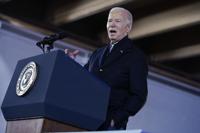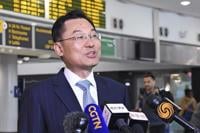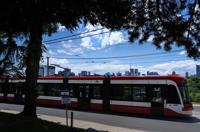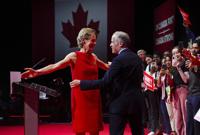Several Ontario mayors have been calling on the province to ban financial incentives municipalities use to lure in doctors, saying the recruitment tactic is harming communities that can't pony up the cash ŌĆō especially those in rural and northern regions.
But Sault Ste. Marie Mayor Matthew Shoemaker is going even further, suggesting the federal government should outlaw the practice from "coast to coast."┬Ā
ŌĆ£I think it should be banned across the country actually," he said in a recent interview.┬Ā
Shoemaker said his city needs 40 more doctors, including 18 to practise family medicine, and while it does offer a moving allowance of up $10,000, it is not in a position to compete with municipalities that are offering doctors tens of thousands of dollars to relocate.
"We think incentives are bad and we don't agree with them, and so we're not at this point supportive of getting into a competition on incentives because it is a competition we will lose," he said.
Shoemaker said he asked Ontario's health minister to intervene and stop the practice during a meeting they had last August. But he said there seems to be no appetite for such a move in Ontario unless there is "more widespread acceptance of banning of incentives" across the country.
"We don't want to become the place that is having all its doctors taken away from us," he said.┬Ā
A Ministry of Health spokesperson said the government has made big investments to connect more Ontarians with doctors, but didn't directly respond to a question on whether it would consider banning municipalities' financial incentives.
Shoemaker isn't the only one raising concern over the use of incentive-based programs to address Ontario's doctor shortage.
Todd Kasenberg, the mayor of North Perth, is also encouraging the province to ban cash incentives, which he calls a "mistake." ┬Ā
"We've entered an arms race and typically there aren't any winners in an arms race," he said in an interview.
Kasenberg said around 3,000 of 17,000 people in his town north of London, Ont., are currently without a family doctor. With expected retirements in the next few years, the doctor shortage will be severe if officials can't recruit fast enough.
"So it's a substantial issue and met with a lot of frustration in the community, a lot of anxiety," he added.
He said the town is expected to welcome four medical residents from Western University this year. Council approved spending $50,000 to provide housing support for those residents, even though Kasenberg said he was personally "uncomfortable" with the move.┬Ā
He hopes the recruits will stay in town beyond their residency period.┬Ā
London Mayor Josh Morgan and Peterborough Mayor Jeff Leal have also publicly criticized municipalities' financial incentives for doctor recruitment.┬Ā
Ontario's long-standing shortage of primary care providers affects millions of patients in every corner of the province, but advocates say rural communities are hit harder because they have fewer hospitals and walk-in clinics.
Experts have long warned that hefty financial incentives offered to doctors are widening the health-care access gap between poorer rural towns and richer urban centres.
Some say while the incentives might work, particularly in recruiting new graduates and medical residents who have education loans to repay, they don't serve to retain doctors in those communities.┬Ā
"I think it is much more effective to be able to, from a retention standpoint, to support new grads by helping them to manage their schedule, add work slowly, avoid the risk of burnout," said Dr. Sarah Newbery, a family physician in Marathon, Ont., a rural community 300 kilometres east of Thunder Bay.
"If they're too busy from the get-go, they will not be easy to retain."
Newbery knows a thing or two about retention ŌĆō she was one of six young physicians who moved to Marathon nearly three decades ago and ended the town's chronic doctor shortage.┬Ā
At that time, Marathon was about to lose its only emergency department and the fate of the entire hospital was up in the air. The local physician recruitment committee even had burlap sacks ready to cover the hospital signs on the nearby highway.┬Ā
ŌĆ£It was probably the most underserviced community certainly in the province, maybe in the country," Newbery said.┬Ā
She said the town gave the entire group $10,000 in bonuses ŌĆö a little over $1,600 each ŌĆö and housing support that included two years of free rent for some. But those incentives were not a deciding factor for Newbery and her partner to stay in Marathon for 29 years.┬Ā
She said what kept that group of physicians in town was a collective commitment to provide better care for the community as well as an understanding of a healthy work and life balance. Marathon is home to six physicians now, and has only one doctor vacancy at a time when other rural communities are in a health-care crisis.
Instead of offering cash bonuses, Newbery suggested the money should be invested in making towns more welcoming and appealing to doctors in the long run.
Around 525,000 Ontarians who live in rural areas have no access to primary care, and that number is increasing four times faster compared to urban centres, according to data provided by the Rural Ontario Municipalities Association.┬Ā
Christy Lowry, the associationŌĆÖs chair, said improving access to health care, recruiting physicians and medical workers, and making sure local emergency rooms remain operational are "top priority" for the association.
"All of those pieces are part of what we're focused on right now, and we can see how the lack of these services are negatively impacting our communities and the well-being of our communities," she said.
Lowry, who is also the mayor of Mississippi Mills, a rural community east of Ottawa, said while her town has a modern hospital with "tremendous service," the shortage of primary care providers is a problem for residents, some of whom are travelling as far as Kingston to see their doctors.┬Ā
The association estimates Ontario municipalities are spending nearly half a billion dollars on health care annually.┬Ā
"Property tax dollars should be going to core municipal priorities. They were never designed to pay for health services," Lowry said in a recent interview.┬Ā
"The problem is there's a shortage. (We) don't have enough, so it becomes this competition between one community and the next."
In northern communities, more than 350 doctors ŌĆö including more than 200 family physicians ŌĆö are needed to fill current vacancies, and that number is much higher if retirements expected over the next five years are factored in, according to the Ontario Medical Association.┬Ā
The association's former president, Dr. Dominik Nowak, said that's "unacceptable.ŌĆØ┬Ā
The shortage had led to fierce competition for physicians. ┬Ā┬Ā
"There are winners and losers when we have a situation like this and oftentimes the communities that can't afford to recruit and retain are northern and rural communities," he said last month before his tenure ended.┬Ā
Nowak said while municipalities should help create a welcoming environment for doctors and their families, ultimately it is the province's job to ensure communities have proper access to health care.┬Ā
"It's a symptom of a larger problem," Nowak said of incentive-based programs. "The larger problem is that family practice is no longer seen as a viable career choice for new graduates."
The Ministry of Health said the province has added 15,000 doctors and increased the number of family physicians by 10 per cent since 2018.┬Ā
Ministry spokesperson Ema Popovic said the government is adding close to 1,500 family doctors in rural and northern areas as part of two different programs, which include bringing in foreign-trained doctors and providing education funds for students interested in working in those communities. ┬Ā
She said Ontario aims to connect everyone in the province to a primary care provider by 2029 as part of a $1.8-billion investment.
The province recently said there will be "significant investments" in the Rural and Northern Physician Group Agreement primary care model. There will also be a new program called the Rural Emergency Medicine Coverage Investment Fund, which is meant to ensure appropriate doctor staffing levels year-round, and it replaces a now-expired temporary program that incentivized doctors to fill those shifts in rural and northern ERs.┬Ā
This report by ║┌┴Ž│į╣Ž═° was first published May 8, 2025.┬Ā







































